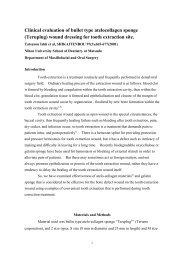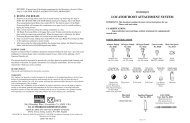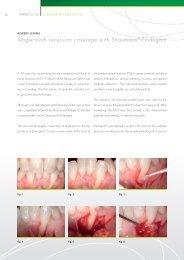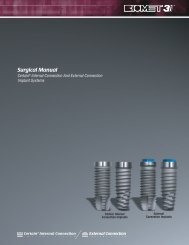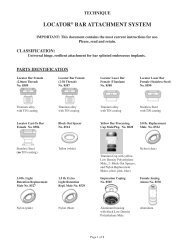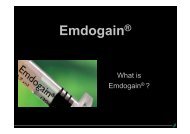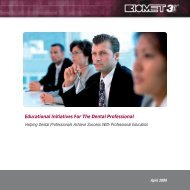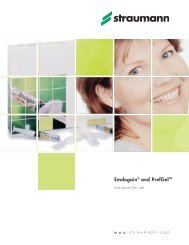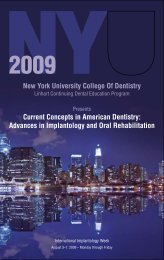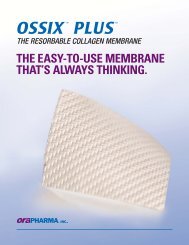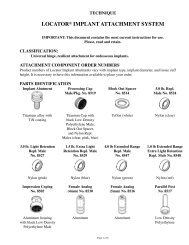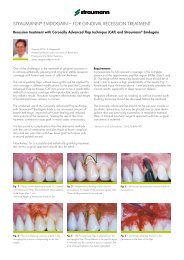Research Dossier
Research Dossier
Research Dossier
- No tags were found...
You also want an ePaper? Increase the reach of your titles
YUMPU automatically turns print PDFs into web optimized ePapers that Google loves.
Discrete Calcium Phosphate Nanocrystals Render Titanium SurfacesBone Bonding*Vanessa C. Mendes, John E. Davies, Institute of Biomaterials and Biomedical Engineering, Faculty of Dentistry,University of Toronto, OntarioCanadian Biomaterials Society25th Annual Meeting (May 26–28, 2006, Calgary, Alberta,Canada)IntroductionThe surfaces of titanium dental implants have evolved witha variety of microtextures that have been shown to accelerateearly bone healing and increase implant stability [1,2].Specifically, microtextured surfaces of either metallic orcalcium phosphate (CaP) implants have been shown toimprove healing by upregulation of platelet activation [3,4]and increasing fibrin retention to the implant surface; whichare elements necessary to signal, and provide a transientbiological matrix for, osteogenic cell migration to the implantsurface that results in contact osteogenesis [5]. An additionalbenefit of CaP coatings – usually ≥ 50 microns thick – is thatthey have been shown to not only accelerate early healingbut also permit bone bonding to their surfaces. The latter isa benefit unobtainable with metallic surfaces [6].Nevertheless, CaP plasma-sprayed implants also havedemonstrated clinical problems due to delamination andresultant particulate formation in vivo which have led toinflammatory responses and implant failure under loading.For this reason, particularly in the dental implant field, CaPcoatedsurfaces have been largely replaced by microtexturedmetallic surfaces.Recently, it has been shown that it is possible to modify analready clinically successful microtextured metallic surfaceby the deposition of discrete nano-crystals of CaP. Thesedeposited crystals have little effect on the micron-scale textureof the metallic surface, but do superimpose upon it a nanoscaletopographical complexity. Indeed, we show elsewhereat this conference that such discrete CaP crystalline deposits(DCD) can significantly accelerate osteoconduction. Thepurpose of the present study was to design an experimentto ask the question: Can such CaP/DCD render a metallicimplant surface bone-bonding? To address the question, wedesigned custom implants to measure the strength ofattachment of bone to a candidate implant surface.particulate sol-gel deposition method). Thus, a total of fourgroups: cp, cpDCD, alloy, and alloyDCD were generated. Fortyeight implants (12 per group) were placed antero-posteriorlyinto the distal metaphyses of both femora of male Wistar ratsfor nine days. The femora of the sacrificed animals weretrimmed to the width of the implant and placed in sucrosebuffer. The resulting samples consisted of two cortical archesof bone attached to each implant (n=96). For each sample,nylon lines were passed through the marrow spaces betweenthe implant and each cortical arch and the implant wassecured in a vice attached to an Instron Testing Machine(model 8501) (Figure 1).Each nylon line was thenattached to the InstronFrame, displaced at acrosshead speed of30mm/min, and the force torupture the sample wasrecorded. Thus, for eachimplant, two force/displacementresults were generated,one for each femoral arch(medial or lateral). Scanningelectron microscopy (SEM)Figure 1: Preparation of samplefor the tensile test.was used as a qualitative method to analyze the bone/implantinterface following the detachment assay.Results And DiscussionThe post-operative period was uneventful for all rats, exceptone, which had problems load-bearing and was excludedfrom the study. One sample was compromised while beingpositioned in the Instron Machine. Thirty two arches (16 cp,2 cpDCD, 12 alloy and 2 alloyDCD) were insufficientlyattached to the surface of their implant to withstand samplehandling. These data were included in the study. The resulting63 samples were tested as described above. DCD implantsurfaces, either cp or alloy, had statistically significantlygreater average values of detachment force (cp 7.08N andalloy 11.30N) than controls (cp 0.60N and alloy 1.90N)(Figure 2). Furthermore, DAE alloy surfaces exhibitedMaterials And MethodsCustom designed rectangular implants, 6x4x1.5mm, werefabricated from either commercially pure (“cp”) or titaniumalloy (Ti6Al4V or “alloy”). Each implant had a central holedown the long axis to enable suture fixation at surgery. Allimplants were dual-acid-etched (DAE) using either H 2SO 4/HClor HCl/HF for cp and alloy implants respectively. Half of thecp and alloy implants were modified by the CaP/DCD (nominalcrystal size 20nm; surface coverage approx. 50%; modifiedForceTensile Force ValuesFigure 2: Tensile force values for all four groups.*Bone Bonding is the interlocking of bone with the implant surface.11



